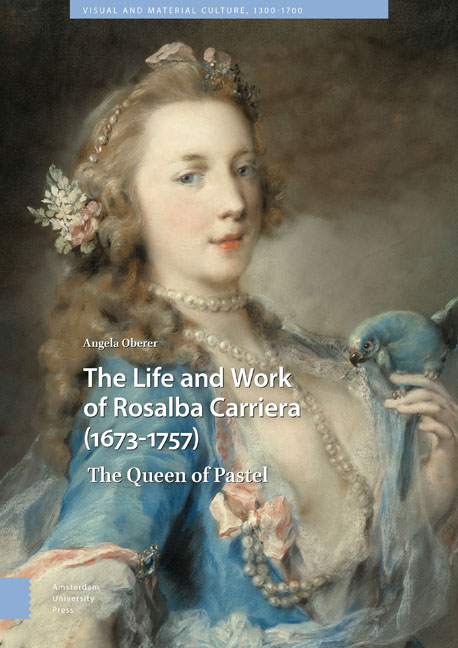Book contents
- Frontmatter
- Contents
- List of Figures and Plates
- Introduction
- 1 Rosalba Carriera – An Independent Single Artist in Eighteenth-Century Venice
- 2 Carriera's Discovery of Pastel Painting
- 3 Carriera's International Network
- 4 Carriera's Stay in Paris
- 5 Carriera's Oeuvre in Pastel
- 6 The Single Woman, the Spinster
- 7 Carriera's Last Journeys – The End of an E`nviable Career
- 8 Carriera's Ways of Self-Fashioning
- Conclusion
- Bibliography
- Index
5 - Carriera's Oeuvre in Pastel
Published online by Cambridge University Press: 24 November 2020
- Frontmatter
- Contents
- List of Figures and Plates
- Introduction
- 1 Rosalba Carriera – An Independent Single Artist in Eighteenth-Century Venice
- 2 Carriera's Discovery of Pastel Painting
- 3 Carriera's International Network
- 4 Carriera's Stay in Paris
- 5 Carriera's Oeuvre in Pastel
- 6 The Single Woman, the Spinster
- 7 Carriera's Last Journeys – The End of an E`nviable Career
- 8 Carriera's Ways of Self-Fashioning
- Conclusion
- Bibliography
- Index
Summary
The great number of pastel paintings that Carriera produced in her lifetime includes a vast variety of images that represent a personal and at times very specific visual interpretation of the world around her. The many facets involved in her reading of late seventeenth- and eighteenth-century society include reflections of the ‘Venetian myth’, questions regarding her artistic legacy and the matter of social norms relating to individual appearance. Her art also shows similarities between her preferred medium, pastel painting, and fashionable cosmetics, and one particular issue that concerns the importance of ‘owning a Carriera’ leading to the importance of ‘being a Carriera’; her paintings also mirror the artist's outstanding capacity for psychological insight and her high level of education and erudition.
Carriera's Portraits within the Venetian Tradition
By the end of the seventeenth and beginning of the eighteenth century, Venice was a republic in decline, on a political, economic and social level. At the same time, in what seems paradoxical development, cultural production flourished and the visual arts recovered from a century of stagnant conformity and indecisiveness before they ‘flared up in a final, multifarious and brilliant blaze.’ It was also a period in which painters started finding solutions to what Sohm has called an artistic dilemma and Zarrillo a ‘neurosis of visual legacy’. With her reading of artistic development in those years, Zarrillo added in important respects to the general idea of it being a time of nostalgia, of ‘a sentiment of loss’. She describes an apparently insurmountable difficulty for painters in Venice that had been noticed since the seventeenth century: whether to continue to reinterpret the Renaissance tradition, which implied the stagnation of stylistic retrospection, or to take the risk of brutally departing from their celebrated precedents. Furthermore, as Zarrillo points out, there was the question of how to react in reference to the earlier personification of state identity. To what degree would artists decide to stick to the famous Venetian myth that had been carefully constructed over the last 300 years? Was it still possible to visually transmit the Venetian ‘dream of might and righteousness’? On which grounds would painters continue to celebrate the city's aspects of divinity that it had thanks to its mythological founding on Annunciation Day (25 March), and how could they still glorify its legendary wealth, infinite beauty, boundless fame, eternal peace and political stability?
- Type
- Chapter
- Information
- Life and Work of Rosalba Carriera (1673–1757)The Queen of Pastel, pp. 165 - 216Publisher: Amsterdam University PressPrint publication year: 2020

